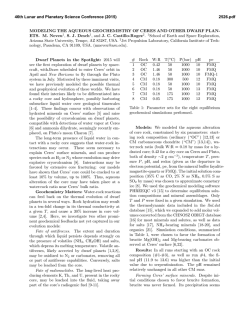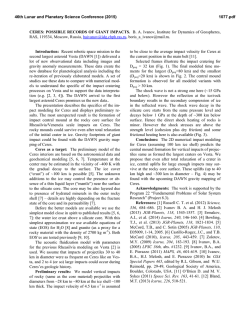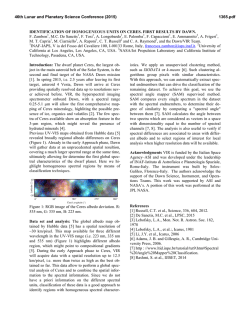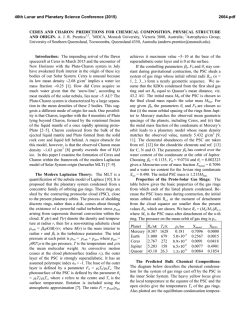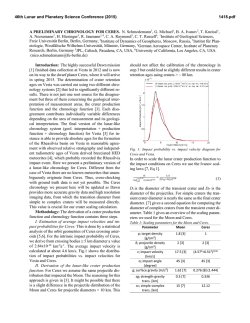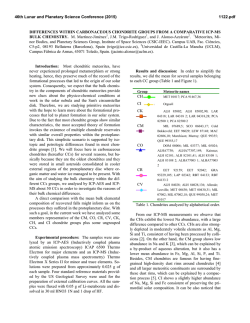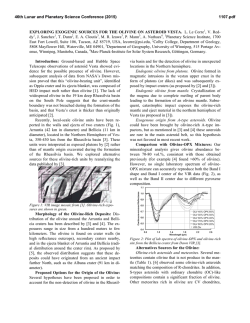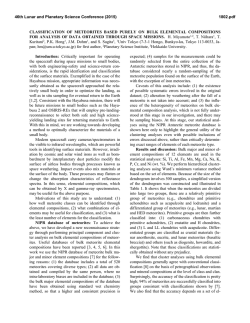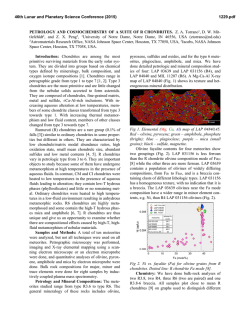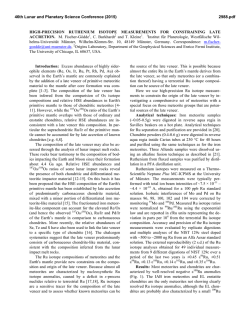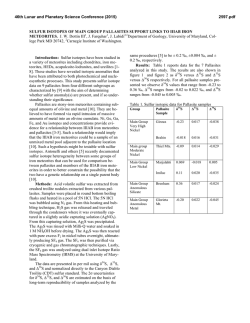
EXPLORING SOURCES OF EXOGENIC MATERIAL ON CERES. L
46th Lunar and Planetary Science Conference (2015) 1431.pdf EXPLORING SOURCES OF EXOGENIC MATERIAL ON CERES. L. Le Corre1, V. Reddy1, W. F. Bottke2, M. Dykhuis3, A. Nathues4, 1Planetary Science Institute, Tucson, Arizona, [email protected], 2 SwRI, Boulder, Colorado, 3Lunar and Planetary Lab., Univ. of Arizona, Tucson, Arizona, 4Max-Planck-Institute for Solar System Research, Göttingen, Germany. Introduction: Dwarf planet Ceres is the largest and the most massive object in the main asteroid belt. Liquid water or water ice is thought to dominate its mantle while its surface is most probably aqueously altered (e.g., [1] and [2]). Surface albedo or compositional variations on the surface of Ceres were observed using Hubble Space Telescope (HST) data [3], and [2] showed that spectral properties of Ceres vary with rotational phase. However, the surface composition of Ceres is not well constrained from ground-based and space-based telescopes observations. NASA’s Dawn mission will enter orbit around Ceres in April 2015 to characterize its surface and understand its internal structure and origin. On Vesta, Dawn discovered exogenic material in the form of remnant carbonaceous [4] and possibily ordinary chondrite [5] impactors. These exogenic terrains have albedo and spectral properties that were distinct from Vestan material enabling their easy identification using Dawn Framing Camera (FC) color filter and VIR data. Evidence from the study of HED meteorites also supported the presence of exogenic material on Vesta. In contrast, there are no known meteorites from Ceres and our ability to predict what exogenic material we might find on Ceres is limited. Possible Hypothesis: In an effort to predict what exogenic material one might find on Ceres, we looked at asteroid families close to Ceres in dynamical space that show distinct spectral features and higher albedo. One family that fit these criteria is the Gefion family, which is in dynamical proximity to Ceres. Dynamical models of asteroid family evolution and meteorite delivery mechanisms led [6] and [7] to suggest the Gefion family as the source of the L-chondrites. A majority of L chondrites record an intense shock event ~470 Ma, interpreted as evidence of the breakup and dispersal of the L chondrite parent body. [6] and [7] used dynamical models to connect the Gefion familyforming collision event with this shock history. Following the formation of the Gefion family, “fossil” L chondrite meteorites dominated the impactor population arriving at Earth ~470 million years ago [6]. Depending on the assumptions made, a brief burst of Gefion fragments could also potentially dominate the small impactor population at Ceres near this time. Thus, exogenic L chondrite material conceivably could be found on Ceres. While a short-lived impact spike would mainly create small craters, their signature would then be diluted by ~470 My of crater production superposed on them from other main belt impactors. This may make it difficult to identify L chondrite craters or their remnant fragments on Ceres, though hopefully it is not impossible. Proposed Methodology: Given Ceres’ low albedo (0.09), only bright exogenic impactors will be easily identifiable. Another criterion for identification is the spectral shape of the exogenic material. Bright impactors such as E-types (enstatite achondrites) lack diagnostic absorption bands deep enough to be distinguishable with the Dawn FC color filter data. Here we present color spectra of Ceres and potential ordinary chondrite exogenic materials that have albedos and band depths higher than Ceres. Our goal is to provide a broad baseline for analysis and interpretation of Dawn FC color images of Ceres once Dawn arrives at the dwarf planet. Dawn Framing Camera Filters: FC contains a set of seven color filters ranging from 0.44 to 0.97 µm (Table 1) in addition to a clear filter. Color filters will provide information about the surface composition either through the creation of color composite images allowing the identification of spectrally distinct units, or through the analysis of the color spectra in combination with laboratory spectra of meteorites or minerals that could be good analogues to Ceres. Filter Wavelength cenBandwidth (µm) name ter (µm) F8 0.438 0.040 F2 0.555 0.043 F7 0.653 0.042 F3 0.749 0.044 F6 0.829 0.036 F4 0.917 0.045 F5 0.965 0.086 Table 1: List of FC filters (except clear filter) with their respective center wavelength and band width. Spectral Analysis: In the wavelength range corresponding to the FC filters, the spectrum of Ceres appears almost featureless. Ceres displays a weak absorption band in the NIR wavelengths (centered at ~1.2 µm) thought to be due to magnetite [8] or maybe lizardite [9]. The shorter wavelength shoulder of this band is within the range of three FC filters (F6, F4, 46th Lunar and Planetary Science Conference (2015) F5). As noted earlier, given Ceres’ low albedo and based on HST data, color variations are expected to be subtle [3]. Hence we focused on meteorites with moderate to high albedo exhibiting deep absorption bands and meteorites that are the most likely to impact Ceres (ordinary chondrites). We resampled the ground-based spectrum of Ceres and laboratory spectral data of ordinary chondrites to the FC filter band passes using FC filters responsivity and resampling function in the IDL ENVI software [10]. The FC responsivity corresponds to the combination of filter, CCD and optics transmission measured in the laboratory [11]. Spectra of meteorites were obtained from RELAB and ground-based observations of Ceres are from the Small Bodies Data Ferret. To get the FC color spectrum of Ceres (Fig. 1), we combined data from SMASS (Small Main-Belt Asteroid Spectroscopic Survey with the MDM telescopes at Kitt Peak National Observatory) from [12] and a 52-color IR spectrum of Ceres taken using a double circularly variable filter [13]. Figure 1: Spectrum of Ceres from SMASS and 52color asteroid survey. The first five FC filters use the data from SMASS and the two last filters use data from 52-color asteroid survey. Overall shape is consistent with the shape of Ceres’ spectrum observed with the NASA InfraRed Telescope Facility SpeX instrument [9]. Future Work: We intend to evaluate how different meteoritic components can be identified with FC color filters (Fig. 2), and possibly develop an automated lithology identification software tool that would allow us to classify spectrally distinct units based on a spectral library and color criteria for different meteorites. 1431.pdf Figure 2: Average spectrum of L chondrites from 17 laboratory spectra (RELAB) after resampling to FC filters. Error bars correspond to the maximum and minimum reflectance values found among all the L chondrites used for the average spectrum. References: [1] McCord T.B and Sotin C. (2005) JGR, 110, E05009. [2] Rivkin A.S. et al. (2006) Icarus, 180, 464-472. [3] Li J.-Y. et al. (2006) Icarus, 182, 143-160. [4] Reddy V. et al. (2012) Icarus, 221, 544559. [5] Le Corre L. et al. (in review) Icarus. [6] Nesvorný D. et al. (2009) Icarus, 200, 698-701. [7] Bottke W.F. et al. (2009) LPS XL, Abstract #1445. [8] Larson H.P et al. (1979) Icarus, 39, 257-271. [9] Rivkin A.S. et al. (2011) Space Sci. Rev., 163, 95-116. [10] Le Corre et al. (2011) Icarus, 216, 376-386. [11] Sierks H. et al. (2011) Space Sci. Rev., 163, 263-327. [12] Bus S. and Binzel R.P. (2003) NASA PDS . [13] Bell J.F. et al (1995) NASA PDS. Acknowledgement: This research work was supported by NASA Planetary Mission Data Analysis Program Grant NNX14AN16G, NASA Planetary Geology and Geophysics Grant NNX14AN35G. This research utilizes spectra acquired by Richard P. Binzel, Takahiro Hiroi, Tim McCoy, Harry Y. McSween, David W. Mittlefehldt, Carle M. Pieters, and Allan H. Treiman with the NASA RELAB facility at Brown University.
© Copyright 2025
